Effective Clinical Training Planning and Evaluation
VerifiedAdded on 2021/04/21
|7
|1622
|47
AI Summary
This assignment emphasizes the significance of planning and implementation of clinical training in nursing education. It highlights the importance of creating a well-structured plan that addresses diverse learning needs and personalities. The evaluation method, such as learning style inventori...
Read More
Contribute Materials
Your contribution can guide someone’s learning journey. Share your
documents today.
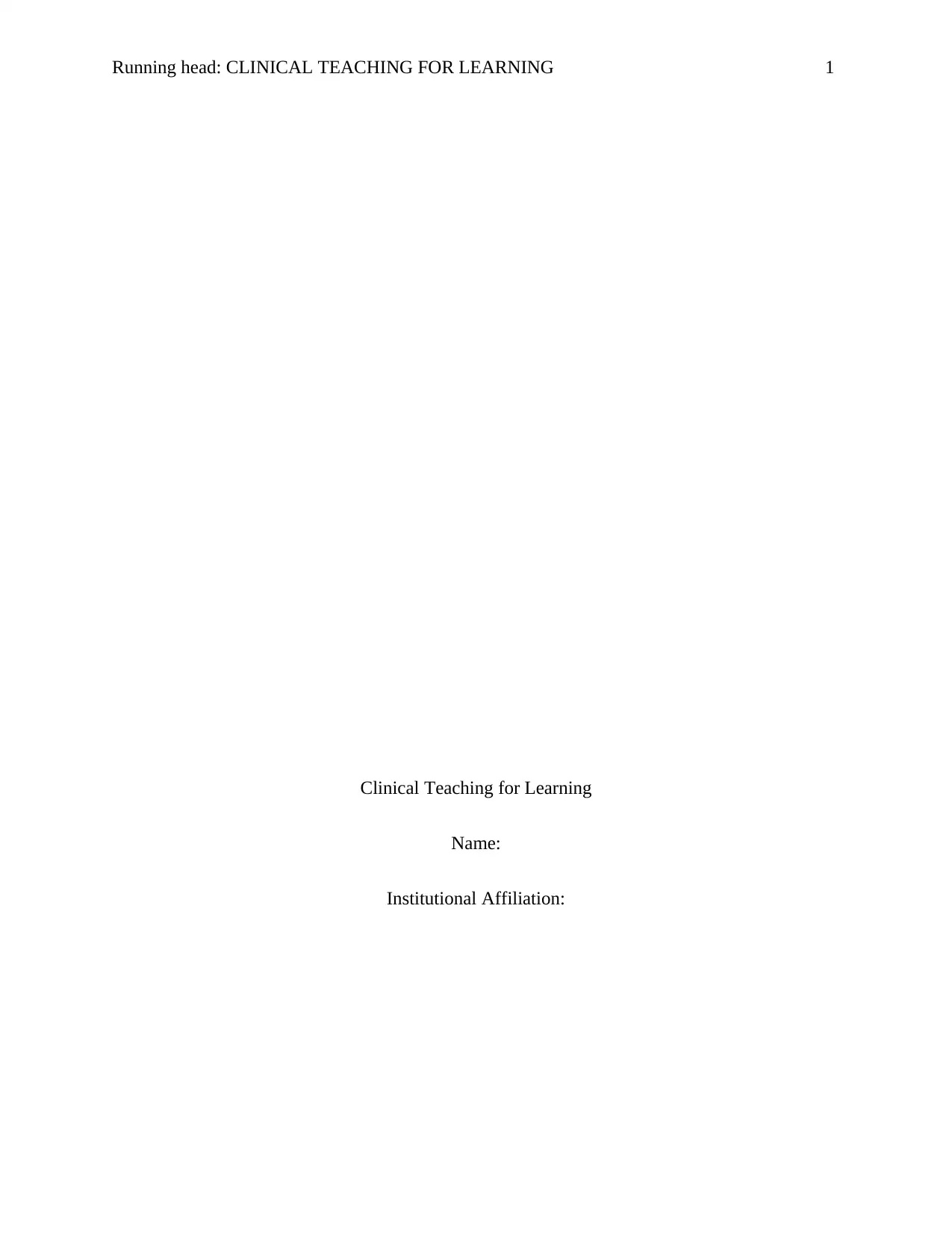
Running head: CLINICAL TEACHING FOR LEARNING 1
Clinical Teaching for Learning
Name:
Institutional Affiliation:
Clinical Teaching for Learning
Name:
Institutional Affiliation:
Secure Best Marks with AI Grader
Need help grading? Try our AI Grader for instant feedback on your assignments.
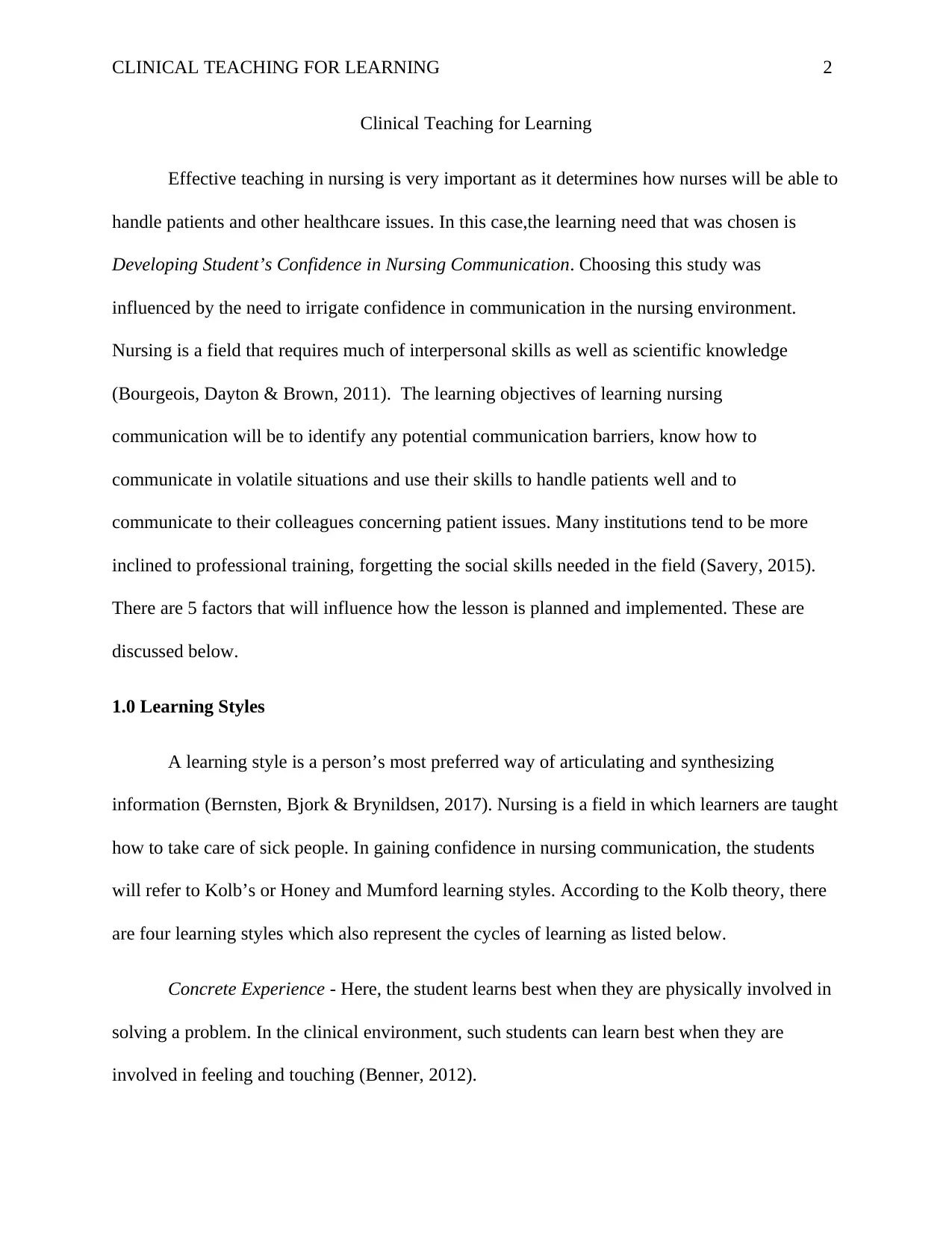
CLINICAL TEACHING FOR LEARNING 2
Clinical Teaching for Learning
Effective teaching in nursing is very important as it determines how nurses will be able to
handle patients and other healthcare issues. In this case,the learning need that was chosen is
Developing Student’s Confidence in Nursing Communication. Choosing this study was
influenced by the need to irrigate confidence in communication in the nursing environment.
Nursing is a field that requires much of interpersonal skills as well as scientific knowledge
(Bourgeois, Dayton & Brown, 2011). The learning objectives of learning nursing
communication will be to identify any potential communication barriers, know how to
communicate in volatile situations and use their skills to handle patients well and to
communicate to their colleagues concerning patient issues. Many institutions tend to be more
inclined to professional training, forgetting the social skills needed in the field (Savery, 2015).
There are 5 factors that will influence how the lesson is planned and implemented. These are
discussed below.
1.0 Learning Styles
A learning style is a person’s most preferred way of articulating and synthesizing
information (Bernsten, Bjork & Brynildsen, 2017). Nursing is a field in which learners are taught
how to take care of sick people. In gaining confidence in nursing communication, the students
will refer to Kolb’s or Honey and Mumford learning styles. According to the Kolb theory, there
are four learning styles which also represent the cycles of learning as listed below.
Concrete Experience - Here, the student learns best when they are physically involved in
solving a problem. In the clinical environment, such students can learn best when they are
involved in feeling and touching (Benner, 2012).
Clinical Teaching for Learning
Effective teaching in nursing is very important as it determines how nurses will be able to
handle patients and other healthcare issues. In this case,the learning need that was chosen is
Developing Student’s Confidence in Nursing Communication. Choosing this study was
influenced by the need to irrigate confidence in communication in the nursing environment.
Nursing is a field that requires much of interpersonal skills as well as scientific knowledge
(Bourgeois, Dayton & Brown, 2011). The learning objectives of learning nursing
communication will be to identify any potential communication barriers, know how to
communicate in volatile situations and use their skills to handle patients well and to
communicate to their colleagues concerning patient issues. Many institutions tend to be more
inclined to professional training, forgetting the social skills needed in the field (Savery, 2015).
There are 5 factors that will influence how the lesson is planned and implemented. These are
discussed below.
1.0 Learning Styles
A learning style is a person’s most preferred way of articulating and synthesizing
information (Bernsten, Bjork & Brynildsen, 2017). Nursing is a field in which learners are taught
how to take care of sick people. In gaining confidence in nursing communication, the students
will refer to Kolb’s or Honey and Mumford learning styles. According to the Kolb theory, there
are four learning styles which also represent the cycles of learning as listed below.
Concrete Experience - Here, the student learns best when they are physically involved in
solving a problem. In the clinical environment, such students can learn best when they are
involved in feeling and touching (Benner, 2012).
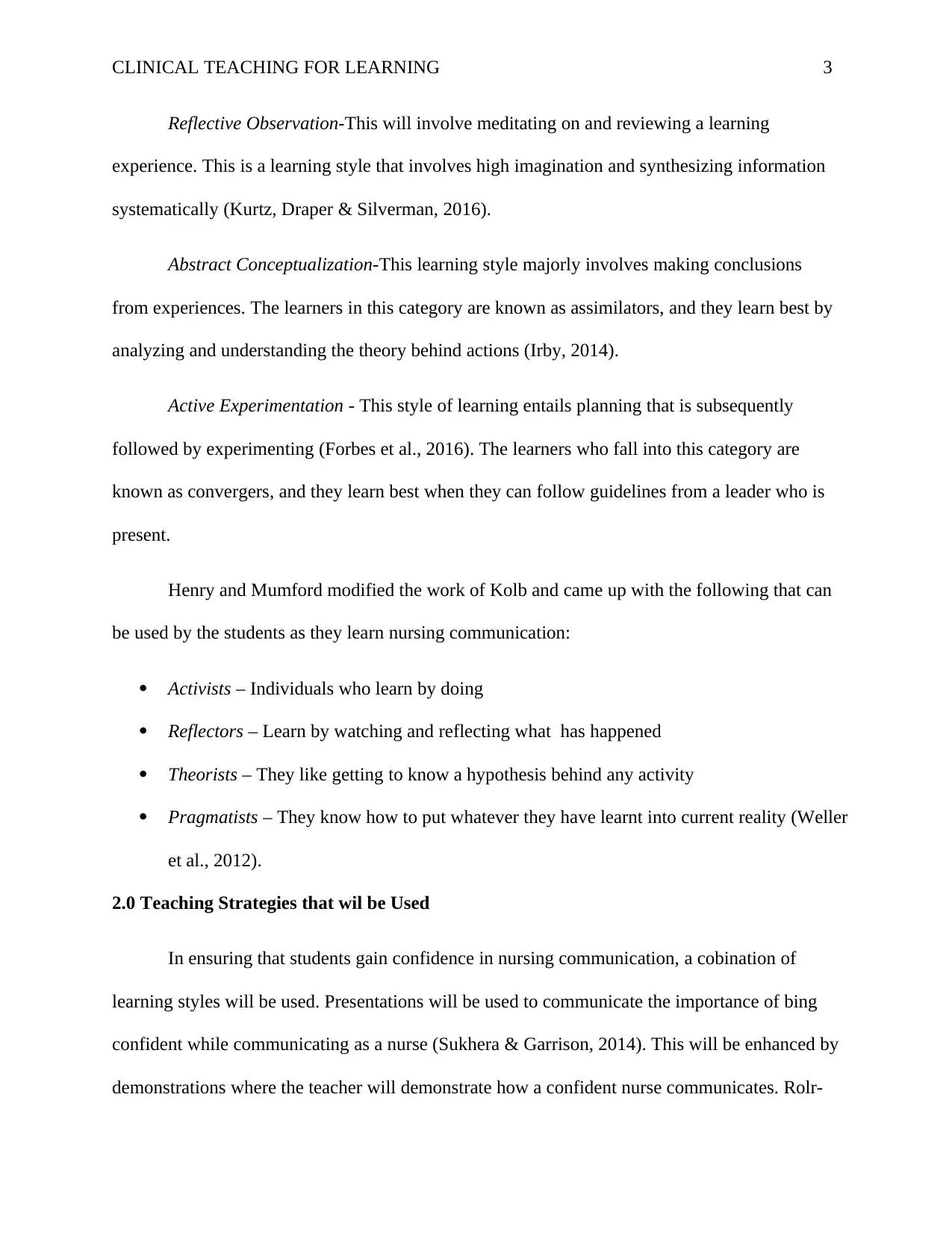
CLINICAL TEACHING FOR LEARNING 3
Reflective Observation-This will involve meditating on and reviewing a learning
experience. This is a learning style that involves high imagination and synthesizing information
systematically (Kurtz, Draper & Silverman, 2016).
Abstract Conceptualization-This learning style majorly involves making conclusions
from experiences. The learners in this category are known as assimilators, and they learn best by
analyzing and understanding the theory behind actions (Irby, 2014).
Active Experimentation - This style of learning entails planning that is subsequently
followed by experimenting (Forbes et al., 2016). The learners who fall into this category are
known as convergers, and they learn best when they can follow guidelines from a leader who is
present.
Henry and Mumford modified the work of Kolb and came up with the following that can
be used by the students as they learn nursing communication:
Activists – Individuals who learn by doing
Reflectors – Learn by watching and reflecting what has happened
Theorists – They like getting to know a hypothesis behind any activity
Pragmatists – They know how to put whatever they have learnt into current reality (Weller
et al., 2012).
2.0 Teaching Strategies that wil be Used
In ensuring that students gain confidence in nursing communication, a cobination of
learning styles will be used. Presentations will be used to communicate the importance of bing
confident while communicating as a nurse (Sukhera & Garrison, 2014). This will be enhanced by
demonstrations where the teacher will demonstrate how a confident nurse communicates. Rolr-
Reflective Observation-This will involve meditating on and reviewing a learning
experience. This is a learning style that involves high imagination and synthesizing information
systematically (Kurtz, Draper & Silverman, 2016).
Abstract Conceptualization-This learning style majorly involves making conclusions
from experiences. The learners in this category are known as assimilators, and they learn best by
analyzing and understanding the theory behind actions (Irby, 2014).
Active Experimentation - This style of learning entails planning that is subsequently
followed by experimenting (Forbes et al., 2016). The learners who fall into this category are
known as convergers, and they learn best when they can follow guidelines from a leader who is
present.
Henry and Mumford modified the work of Kolb and came up with the following that can
be used by the students as they learn nursing communication:
Activists – Individuals who learn by doing
Reflectors – Learn by watching and reflecting what has happened
Theorists – They like getting to know a hypothesis behind any activity
Pragmatists – They know how to put whatever they have learnt into current reality (Weller
et al., 2012).
2.0 Teaching Strategies that wil be Used
In ensuring that students gain confidence in nursing communication, a cobination of
learning styles will be used. Presentations will be used to communicate the importance of bing
confident while communicating as a nurse (Sukhera & Garrison, 2014). This will be enhanced by
demonstrations where the teacher will demonstrate how a confident nurse communicates. Rolr-
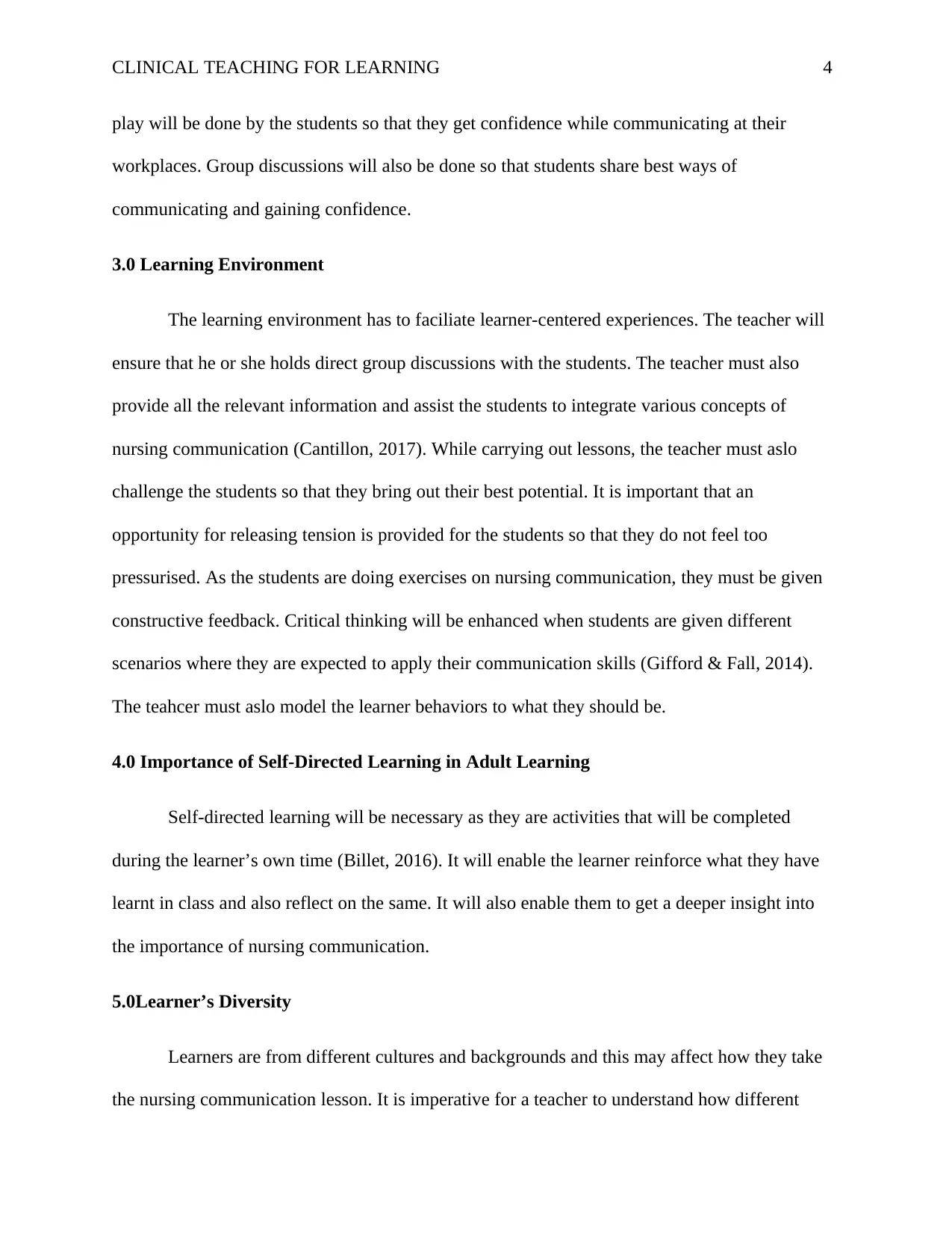
CLINICAL TEACHING FOR LEARNING 4
play will be done by the students so that they get confidence while communicating at their
workplaces. Group discussions will also be done so that students share best ways of
communicating and gaining confidence.
3.0 Learning Environment
The learning environment has to faciliate learner-centered experiences. The teacher will
ensure that he or she holds direct group discussions with the students. The teacher must also
provide all the relevant information and assist the students to integrate various concepts of
nursing communication (Cantillon, 2017). While carrying out lessons, the teacher must aslo
challenge the students so that they bring out their best potential. It is important that an
opportunity for releasing tension is provided for the students so that they do not feel too
pressurised. As the students are doing exercises on nursing communication, they must be given
constructive feedback. Critical thinking will be enhanced when students are given different
scenarios where they are expected to apply their communication skills (Gifford & Fall, 2014).
The teahcer must aslo model the learner behaviors to what they should be.
4.0 Importance of Self-Directed Learning in Adult Learning
Self-directed learning will be necessary as they are activities that will be completed
during the learner’s own time (Billet, 2016). It will enable the learner reinforce what they have
learnt in class and also reflect on the same. It will also enable them to get a deeper insight into
the importance of nursing communication.
5.0Learner’s Diversity
Learners are from different cultures and backgrounds and this may affect how they take
the nursing communication lesson. It is imperative for a teacher to understand how different
play will be done by the students so that they get confidence while communicating at their
workplaces. Group discussions will also be done so that students share best ways of
communicating and gaining confidence.
3.0 Learning Environment
The learning environment has to faciliate learner-centered experiences. The teacher will
ensure that he or she holds direct group discussions with the students. The teacher must also
provide all the relevant information and assist the students to integrate various concepts of
nursing communication (Cantillon, 2017). While carrying out lessons, the teacher must aslo
challenge the students so that they bring out their best potential. It is important that an
opportunity for releasing tension is provided for the students so that they do not feel too
pressurised. As the students are doing exercises on nursing communication, they must be given
constructive feedback. Critical thinking will be enhanced when students are given different
scenarios where they are expected to apply their communication skills (Gifford & Fall, 2014).
The teahcer must aslo model the learner behaviors to what they should be.
4.0 Importance of Self-Directed Learning in Adult Learning
Self-directed learning will be necessary as they are activities that will be completed
during the learner’s own time (Billet, 2016). It will enable the learner reinforce what they have
learnt in class and also reflect on the same. It will also enable them to get a deeper insight into
the importance of nursing communication.
5.0Learner’s Diversity
Learners are from different cultures and backgrounds and this may affect how they take
the nursing communication lesson. It is imperative for a teacher to understand how different
Secure Best Marks with AI Grader
Need help grading? Try our AI Grader for instant feedback on your assignments.
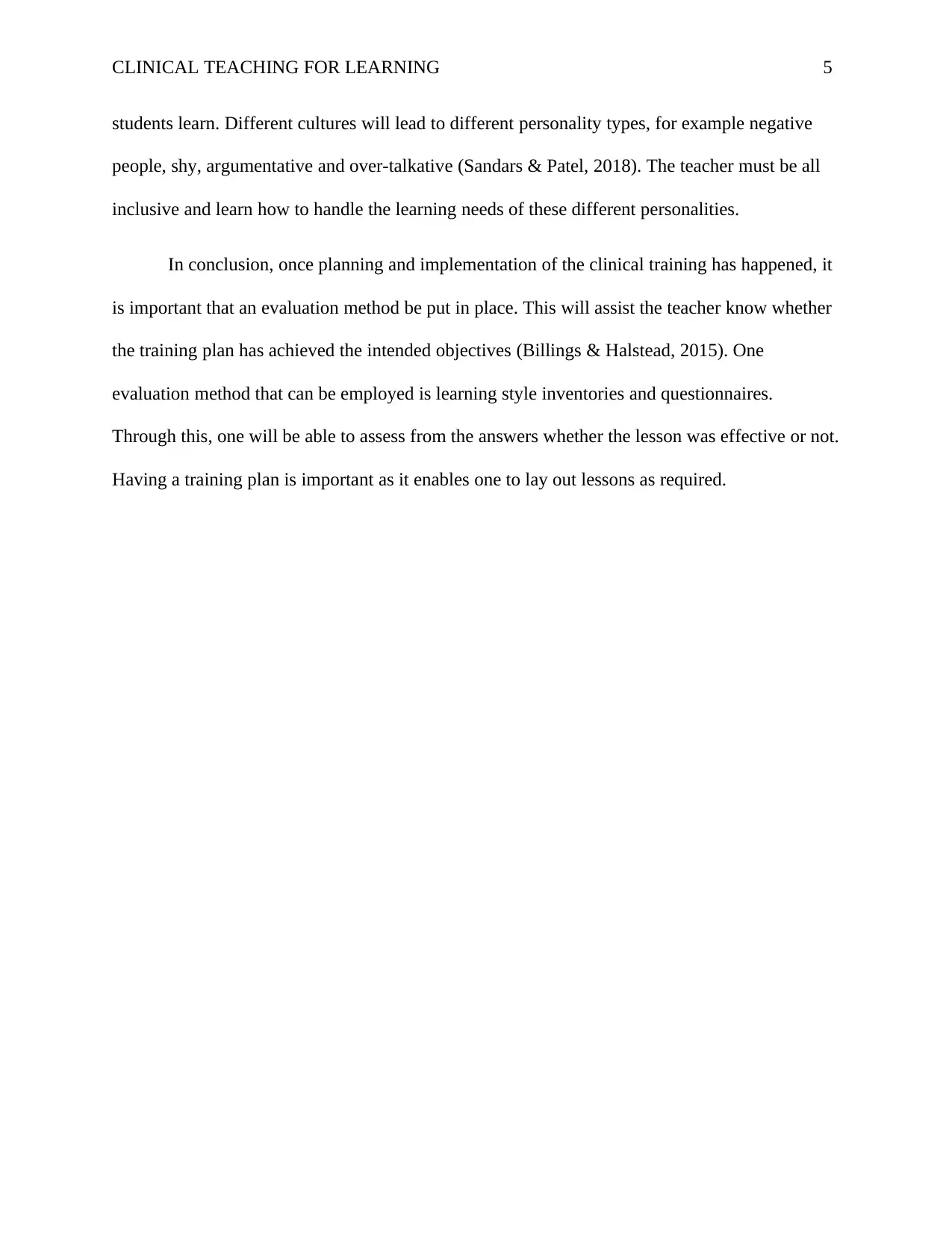
CLINICAL TEACHING FOR LEARNING 5
students learn. Different cultures will lead to different personality types, for example negative
people, shy, argumentative and over-talkative (Sandars & Patel, 2018). The teacher must be all
inclusive and learn how to handle the learning needs of these different personalities.
In conclusion, once planning and implementation of the clinical training has happened, it
is important that an evaluation method be put in place. This will assist the teacher know whether
the training plan has achieved the intended objectives (Billings & Halstead, 2015). One
evaluation method that can be employed is learning style inventories and questionnaires.
Through this, one will be able to assess from the answers whether the lesson was effective or not.
Having a training plan is important as it enables one to lay out lessons as required.
students learn. Different cultures will lead to different personality types, for example negative
people, shy, argumentative and over-talkative (Sandars & Patel, 2018). The teacher must be all
inclusive and learn how to handle the learning needs of these different personalities.
In conclusion, once planning and implementation of the clinical training has happened, it
is important that an evaluation method be put in place. This will assist the teacher know whether
the training plan has achieved the intended objectives (Billings & Halstead, 2015). One
evaluation method that can be employed is learning style inventories and questionnaires.
Through this, one will be able to assess from the answers whether the lesson was effective or not.
Having a training plan is important as it enables one to lay out lessons as required.
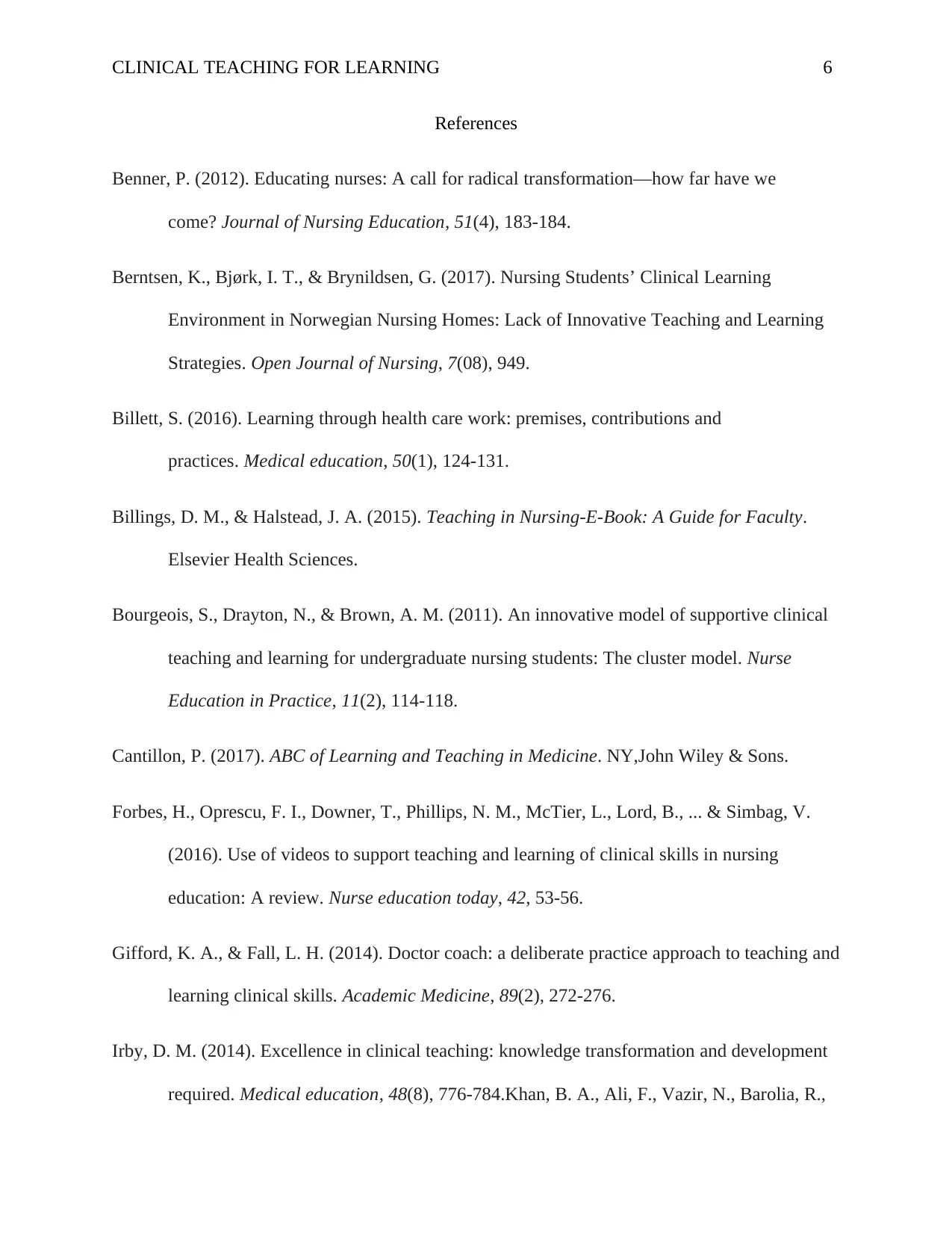
CLINICAL TEACHING FOR LEARNING 6
References
Benner, P. (2012). Educating nurses: A call for radical transformation—how far have we
come? Journal of Nursing Education, 51(4), 183-184.
Berntsen, K., Bjørk, I. T., & Brynildsen, G. (2017). Nursing Students’ Clinical Learning
Environment in Norwegian Nursing Homes: Lack of Innovative Teaching and Learning
Strategies. Open Journal of Nursing, 7(08), 949.
Billett, S. (2016). Learning through health care work: premises, contributions and
practices. Medical education, 50(1), 124-131.
Billings, D. M., & Halstead, J. A. (2015). Teaching in Nursing-E-Book: A Guide for Faculty.
Elsevier Health Sciences.
Bourgeois, S., Drayton, N., & Brown, A. M. (2011). An innovative model of supportive clinical
teaching and learning for undergraduate nursing students: The cluster model. Nurse
Education in Practice, 11(2), 114-118.
Cantillon, P. (2017). ABC of Learning and Teaching in Medicine. NY,John Wiley & Sons.
Forbes, H., Oprescu, F. I., Downer, T., Phillips, N. M., McTier, L., Lord, B., ... & Simbag, V.
(2016). Use of videos to support teaching and learning of clinical skills in nursing
education: A review. Nurse education today, 42, 53-56.
Gifford, K. A., & Fall, L. H. (2014). Doctor coach: a deliberate practice approach to teaching and
learning clinical skills. Academic Medicine, 89(2), 272-276.
Irby, D. M. (2014). Excellence in clinical teaching: knowledge transformation and development
required. Medical education, 48(8), 776-784.Khan, B. A., Ali, F., Vazir, N., Barolia, R.,
References
Benner, P. (2012). Educating nurses: A call for radical transformation—how far have we
come? Journal of Nursing Education, 51(4), 183-184.
Berntsen, K., Bjørk, I. T., & Brynildsen, G. (2017). Nursing Students’ Clinical Learning
Environment in Norwegian Nursing Homes: Lack of Innovative Teaching and Learning
Strategies. Open Journal of Nursing, 7(08), 949.
Billett, S. (2016). Learning through health care work: premises, contributions and
practices. Medical education, 50(1), 124-131.
Billings, D. M., & Halstead, J. A. (2015). Teaching in Nursing-E-Book: A Guide for Faculty.
Elsevier Health Sciences.
Bourgeois, S., Drayton, N., & Brown, A. M. (2011). An innovative model of supportive clinical
teaching and learning for undergraduate nursing students: The cluster model. Nurse
Education in Practice, 11(2), 114-118.
Cantillon, P. (2017). ABC of Learning and Teaching in Medicine. NY,John Wiley & Sons.
Forbes, H., Oprescu, F. I., Downer, T., Phillips, N. M., McTier, L., Lord, B., ... & Simbag, V.
(2016). Use of videos to support teaching and learning of clinical skills in nursing
education: A review. Nurse education today, 42, 53-56.
Gifford, K. A., & Fall, L. H. (2014). Doctor coach: a deliberate practice approach to teaching and
learning clinical skills. Academic Medicine, 89(2), 272-276.
Irby, D. M. (2014). Excellence in clinical teaching: knowledge transformation and development
required. Medical education, 48(8), 776-784.Khan, B. A., Ali, F., Vazir, N., Barolia, R.,
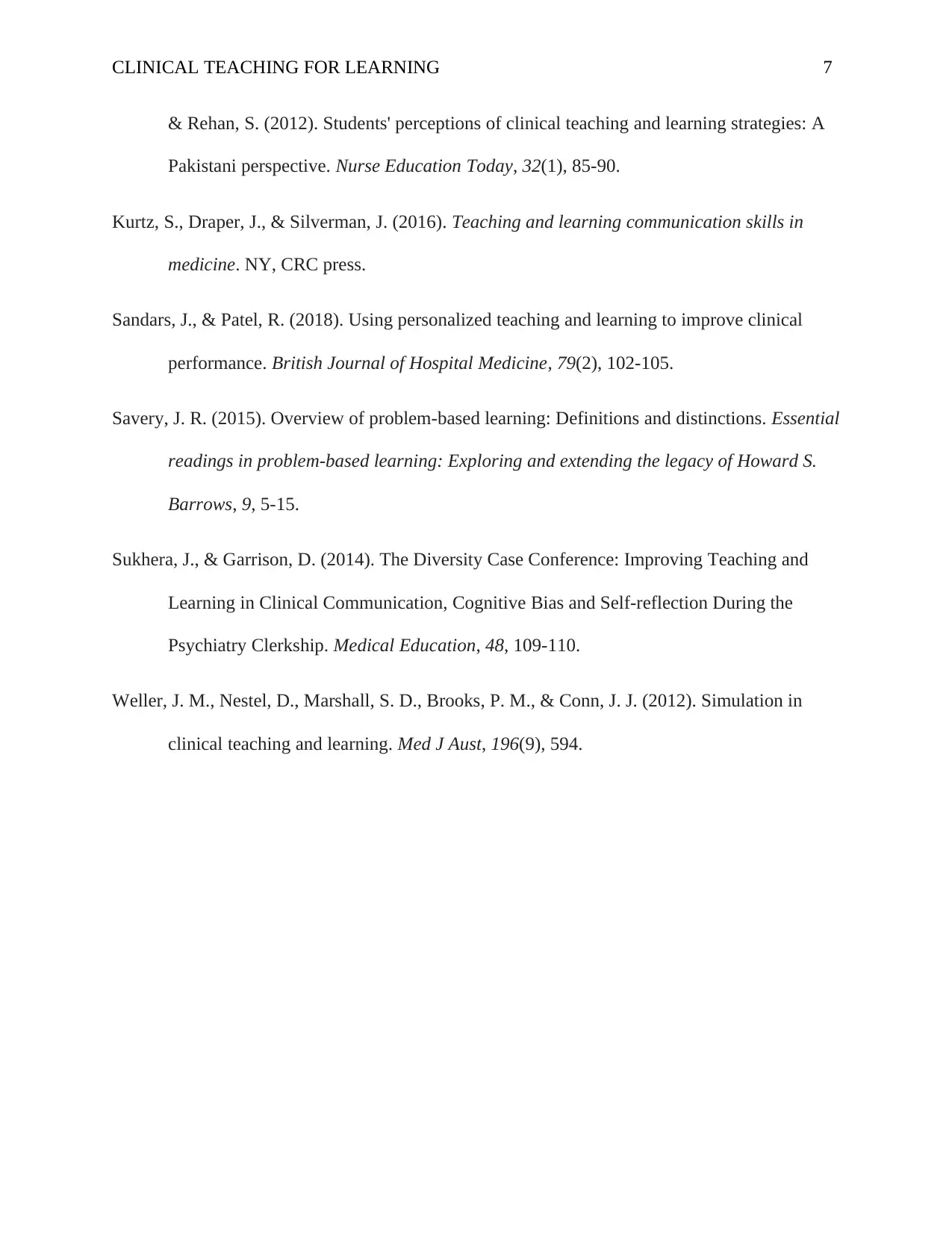
CLINICAL TEACHING FOR LEARNING 7
& Rehan, S. (2012). Students' perceptions of clinical teaching and learning strategies: A
Pakistani perspective. Nurse Education Today, 32(1), 85-90.
Kurtz, S., Draper, J., & Silverman, J. (2016). Teaching and learning communication skills in
medicine. NY, CRC press.
Sandars, J., & Patel, R. (2018). Using personalized teaching and learning to improve clinical
performance. British Journal of Hospital Medicine, 79(2), 102-105.
Savery, J. R. (2015). Overview of problem-based learning: Definitions and distinctions. Essential
readings in problem-based learning: Exploring and extending the legacy of Howard S.
Barrows, 9, 5-15.
Sukhera, J., & Garrison, D. (2014). The Diversity Case Conference: Improving Teaching and
Learning in Clinical Communication, Cognitive Bias and Self-reflection During the
Psychiatry Clerkship. Medical Education, 48, 109-110.
Weller, J. M., Nestel, D., Marshall, S. D., Brooks, P. M., & Conn, J. J. (2012). Simulation in
clinical teaching and learning. Med J Aust, 196(9), 594.
& Rehan, S. (2012). Students' perceptions of clinical teaching and learning strategies: A
Pakistani perspective. Nurse Education Today, 32(1), 85-90.
Kurtz, S., Draper, J., & Silverman, J. (2016). Teaching and learning communication skills in
medicine. NY, CRC press.
Sandars, J., & Patel, R. (2018). Using personalized teaching and learning to improve clinical
performance. British Journal of Hospital Medicine, 79(2), 102-105.
Savery, J. R. (2015). Overview of problem-based learning: Definitions and distinctions. Essential
readings in problem-based learning: Exploring and extending the legacy of Howard S.
Barrows, 9, 5-15.
Sukhera, J., & Garrison, D. (2014). The Diversity Case Conference: Improving Teaching and
Learning in Clinical Communication, Cognitive Bias and Self-reflection During the
Psychiatry Clerkship. Medical Education, 48, 109-110.
Weller, J. M., Nestel, D., Marshall, S. D., Brooks, P. M., & Conn, J. J. (2012). Simulation in
clinical teaching and learning. Med J Aust, 196(9), 594.
1 out of 7
Related Documents
Your All-in-One AI-Powered Toolkit for Academic Success.
+13062052269
info@desklib.com
Available 24*7 on WhatsApp / Email
![[object Object]](/_next/static/media/star-bottom.7253800d.svg)
Unlock your academic potential
© 2024 | Zucol Services PVT LTD | All rights reserved.




